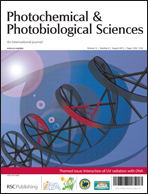Exposure to the UV component of sunlight is the principal factor leading to skin cancer development. Cyclobutane pyrimidine dimers (CPD) are considered to be the most important pre-mutagenic type of DNA damage involved in skin carcinogenesis. To better understand the biological mechanisms of UV carcinogenesis, it is critical to understand the CPD distribution between the four types of dipyrimidine sites. Most of our knowledge regarding CPD distribution comes from in vitro studies or from investigations using UVC, even though we are not naturally exposed to these UV wavelengths. We exposed normal human fibroblasts and purified DNA to UVB. Using ligation-mediated PCR, we quantified the CPD formation at 952 dipyrimidine sites among the PGK1 (phosphoglycerate kinase 1), JUN, HRAS, KRAS, NRAS and TP53 genes. In cellulo, we found a CPD distribution of 27 : 27 : 25 : 21 for TT : CC : TC : CT. This distribution is similar to that observed in vitro. In the analysed genes, we observed some extremely frequently damaged dipyrimidine sites and many of these occurred at potentially frequently mutated sites, i.e. at dipyrimidine sites containing cytosine. Also, most of the frequently damaged dipyrimidine sites in cellulo that are not frequently damaged in vitro are found on TP53 and NRAS. This indicates that many of the frequently damaged dipyrimidine sites in cellulo are on genes frequently mutated in skin cancer. All these results support the view that CPD are the main UVB-induced mutagenic photoproducts and provide evidence of the importance of CPD formation at sites containing cytosine.

You have access to this article
 Please wait while we load your content...
Something went wrong. Try again?
Please wait while we load your content...
Something went wrong. Try again?


 Please wait while we load your content...
Please wait while we load your content...